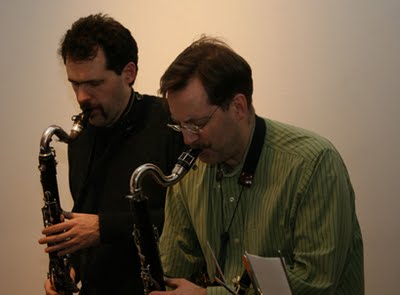Neil Leonard interview

I interviewed Brookline musician Neil Leonard (above right) by phone on Oct. 9, 2009. We spoke about GASP Gallery in Brookline, which he runs with his wife artist Maria Magdalena Campos-Pons. We spoke about the start of the gallery, which is celebrating its fifth year, and its “Sonic Arts” program, which he oversees. Below are some excerpts:
- “Magda needed a studio. This was the primary need. So she found a space that was near to the place where we were living. It was two stories. And she figured she could put her studio at the top and a small gallery at the bottom. My first thought is this is absolutely crazy. We have no time in our lives to administer a gallery, much less what I think she was really thinking about, which was an art center, which would have an educational component, which would have an exhibition space, which would have a concert component. Which is in fact what we have done. My first sense was really I couldn’t take on more because between teaching, performing, parenting I was absolutely full. There were two reasons that went forward doing this together. Number one, I could see that Magda really wanted to do this and it was going to go forward regardless of any caution I might suggest. The other thing was Magda in Cuba was involved as both an artist and a person working in arts administration … She had already been involved as a kind of spokesperson-catalyst in the arts. And I think catalyst is a real thing that appealed to her. Apparently that interest never went away. The fact it didn’t work out there, didn’t mean that it was impossible to do.”
- “One of the things we wanted to experiment with was what does it mean to work with artists of the highest caliber when you’re not a major institution. What I’m getting at is there’s a completely different dialogue that we have with artists in this initial phase where we were kind of doing it all out of our pocket, where essentially we were going to peers or peers would approach us. And they knew what this was, they knew we didn’t have a Mass. Council for the Arts grant, or we didn’t have an NEA grant, or we didn’t have a private sponsor who was covering costs. They know this was something we were kind of doing out of our pocket. They were interested in a combination of things. One they were interested in the venue. In the case of [saxophonist and composer] Steve Lehman, or [composer] Amnon Wolman who did a sound installation in the very beginning in 2005, they were making new work that they wanted to show and they felt they needed to show in order for the work to develop. And they were not working for Documenta or the Venice Biennale or the MoMA or the ICA, one of those blue chip venues to show their work. They wanted a sort of underground place, a small community where they could show their work and they knew that the people they were showing their work in that kind of delicate stage would understand what they’re doing.”
- Magda “She’s always said it’s not where you are, it’s what you make of where you are. … You can do it in Boston. Magda has personally been an example, has shown in the highest level of venues in the world and hasn’t chosen to live in New York. … She’s made herself an example of that personally.”
- “Whatever we don’t have [in Boston] we make. And GASP is one of the ways we do that. And it’s not just recreating New York.” It aims to take the best of all the places they’ve been, from New York to Canada to Cuba to Italy. “And people from all these places come seek us out here.”






0 Comments:
Post a Comment
<< Home